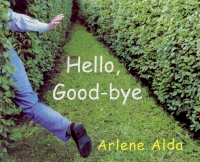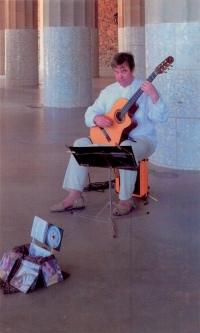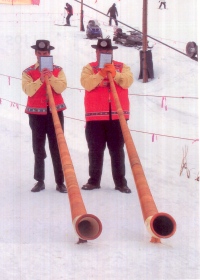| ________________
CM . . .
. Volume XV Number 6. . . .November 7, 2008 
 |
Hello, Good-bye.
Arlene Alda.
Toronto: Tundra Books, 2009.
32 pp., hardcover, $18.99.
ISBN 978-0-88776-900-9.
Preschool-kindergarten / Ages 2-5.
Review by Dave Jenkinson.
**½ /4
Reviewed from Final Pages.
|
| |
|

excerpt:
cold
hot
With a title like Hello, Good-bye, it's pretty obvious that the book's contents are likely going to be about opposites, and such a supposition proves to be correct. The paired opposites are provided both pictorially, via full-colour photos, and also via words, principally a single word for each part of the pairing. On the surface, creating an illustrated book of opposites seems to be an easy task, but it is one that, to use a cliche, is fraught with dangers. In this particular instance, how much the young viewer/listener brings to the book will play a part in determining how successful Alda has been, and I do not think that she has been entirely successful as she often demands too much of her viewers/listeners, especially the younger ones. Before reading the words to children in the book's target age range, it might be most interesting to just let them "talk" to you about what they "see" on each pair of facing pages. I doubt that there will be a great deal of correspondence between the printed words and the children's verbal responses.
 In all, Alda provides 14 pairings: cold/hot, old/new, straight/slanted, wet/dry, below/above, quiet/loud, soft/hard, asleep/awake, push/ pull, parked/on the go, hungry/full, make-believe/real, alone/together and hello/good-bye. Just looking at the word pairings in isolation, most seem to be terms that fall within the "experiences" of the two to five-year-old target audience, though I do question "parked/on the go." The addition of the photos, which should clarify the opposites, sometimes has the potential to complicate a child's understanding of the opposites. For example, most young children understand quiet/loud, if only in terms of "using your inside voice as opposed to your outside voice." However, how do the photos of a single guitar playing man and two men on alpine horns transmit the meaning of those opposites to North American children who might, at best, have heard/seen a guitar being played (and I've heard "loud" guitars). In all, Alda provides 14 pairings: cold/hot, old/new, straight/slanted, wet/dry, below/above, quiet/loud, soft/hard, asleep/awake, push/ pull, parked/on the go, hungry/full, make-believe/real, alone/together and hello/good-bye. Just looking at the word pairings in isolation, most seem to be terms that fall within the "experiences" of the two to five-year-old target audience, though I do question "parked/on the go." The addition of the photos, which should clarify the opposites, sometimes has the potential to complicate a child's understanding of the opposites. For example, most young children understand quiet/loud, if only in terms of "using your inside voice as opposed to your outside voice." However, how do the photos of a single guitar playing man and two men on alpine horns transmit the meaning of those opposites to North American children who might, at best, have heard/seen a guitar being played (and I've heard "loud" guitars).
Soft/hard are illustrated by a photo of baskets of raspberries and blueberries (soft) which are contrasted with shelves of pumpkins (hard). Assuming that children have had prior contact with these two berries and the vegetable, then the contrast might be grasped. The visual forms of old/new are "old" and "new" buildings, but I would anticipate that, without the readers' verbal prompts, pre-reading children will see other forms of opposites in the pictures. Straight/slanted are rendered by architectural photos, but "straight"'s photo also contains curved lines. For me, another problematic photo pairing is below/above which shows the bottom of a tree and the top of a different tree type. Developmentally, the younger portion of the book's target audience will likely have difficulty in mentally "completing" the rest of the tree in order to comprehend the opposites. Parked/on the go uses a photo of a group of bicycles in bike stands while "on the go" is illustrated via someone riding a bike. The meaning of hungry/full is to be understood via photos of two lion statues. The male lion, with his mouth open, is ostensibly hungry while the lioness with her mouth closed is to be understood as "full." The photos of men pushing and pulling a buddha statue are quite weak, especially that of the pull portion of push/pull. While the "push" photo uses a side perspective and viewers can see the three men straining to push the statue, the "pull" photo has the two pullers in line with the statue, with the result being that their pulling motion is much less obvious. Alda's closing pair, hello/goodbye! really asks a lot from young readers as the pairing is "explained" by photos of a sunrise and a sunset.
 While I have generally been critical of the photo choices, a few work better than the others, especially that of a sleeping cat and another on the prowl which provide the visual representation of asleep/awake. An umbrella in the rain and another on the beach do a pretty fair job of capturing wet/dry. Make-believe/real find their visual expressions via a photo of a statue of a female, bikini-clad diver doing a handstand while the leg of a real swimmer projects out of the water in a pool. Alone/together take the form of a single dog and a trio of dogs.
While I have generally been critical of the photo choices, a few work better than the others, especially that of a sleeping cat and another on the prowl which provide the visual representation of asleep/awake. An umbrella in the rain and another on the beach do a pretty fair job of capturing wet/dry. Make-believe/real find their visual expressions via a photo of a statue of a female, bikini-clad diver doing a handstand while the leg of a real swimmer projects out of the water in a pool. Alone/together take the form of a single dog and a trio of dogs.
That Alda's photos will not always immediately elicit the desired paired response is not necessarily a completely bad thing. One of the purposes of concept books, such as Hello, Good-bye, is to assist in expanding a young child's vocabulary, and, if the adult using Hello, Good-bye with the child is open to accepting "incorrect" responses, then Hello, Good-bye will have served its purpose.
Recommended with reservations.
Dave Jenkinson, of Winnipeg, MB, is CM's editor.

To comment
on this title or this review, send mail to cm@umanitoba.ca.
Copyright © the Manitoba Library Association. Reproduction for personal
use is permitted only if this copyright notice is maintained. Any
other reproduction is prohibited without permission.
NEXT REVIEW |
TABLE OF CONTENTS FOR THIS ISSUE
- November 7, 2008.
AUTHORS |
TITLES |
MEDIA REVIEWS |
PROFILES |
BACK ISSUES |
SEARCH |
CMARCHIVE |
HOME |

 In all, Alda provides 14 pairings: cold/hot, old/new, straight/slanted, wet/dry, below/above, quiet/loud, soft/hard, asleep/awake, push/ pull, parked/on the go, hungry/full, make-believe/real, alone/together and hello/good-bye. Just looking at the word pairings in isolation, most seem to be terms that fall within the "experiences" of the two to five-year-old target audience, though I do question "parked/on the go." The addition of the photos, which should clarify the opposites, sometimes has the potential to complicate a child's understanding of the opposites. For example, most young children understand quiet/loud, if only in terms of "using your inside voice as opposed to your outside voice." However, how do the photos of a single guitar playing man and two men on alpine horns transmit the meaning of those opposites to North American children who might, at best, have heard/seen a guitar being played (and I've heard "loud" guitars).
In all, Alda provides 14 pairings: cold/hot, old/new, straight/slanted, wet/dry, below/above, quiet/loud, soft/hard, asleep/awake, push/ pull, parked/on the go, hungry/full, make-believe/real, alone/together and hello/good-bye. Just looking at the word pairings in isolation, most seem to be terms that fall within the "experiences" of the two to five-year-old target audience, though I do question "parked/on the go." The addition of the photos, which should clarify the opposites, sometimes has the potential to complicate a child's understanding of the opposites. For example, most young children understand quiet/loud, if only in terms of "using your inside voice as opposed to your outside voice." However, how do the photos of a single guitar playing man and two men on alpine horns transmit the meaning of those opposites to North American children who might, at best, have heard/seen a guitar being played (and I've heard "loud" guitars).
 While I have generally been critical of the photo choices, a few work better than the others, especially that of a sleeping cat and another on the prowl which provide the visual representation of asleep/awake. An umbrella in the rain and another on the beach do a pretty fair job of capturing wet/dry. Make-believe/real find their visual expressions via a photo of a statue of a female, bikini-clad diver doing a handstand while the leg of a real swimmer projects out of the water in a pool. Alone/together take the form of a single dog and a trio of dogs.
While I have generally been critical of the photo choices, a few work better than the others, especially that of a sleeping cat and another on the prowl which provide the visual representation of asleep/awake. An umbrella in the rain and another on the beach do a pretty fair job of capturing wet/dry. Make-believe/real find their visual expressions via a photo of a statue of a female, bikini-clad diver doing a handstand while the leg of a real swimmer projects out of the water in a pool. Alone/together take the form of a single dog and a trio of dogs.